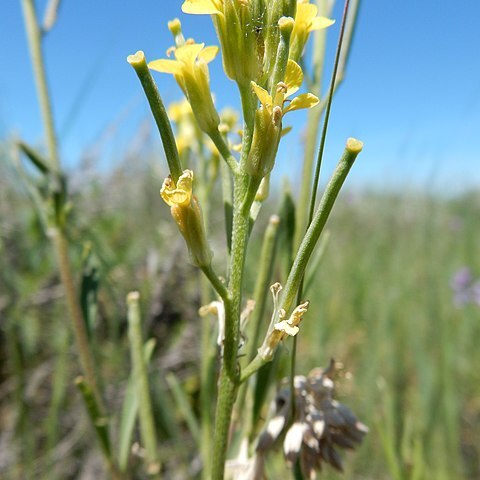Biennials or perennials; (short-lived, caudex thickened, usually simple, rarely branched). Trichomes of leaves 2-or 3-rayed. Stems erect, unbranched or branched distally, 1.5-7 dm. Basal leaves: blade linear to linear-oblanceolate, 1.5-6(-8) cm × 2-8 mm, base attenuate, margins entire or dentate, apex acute. Cauline leaves (distal) sessile; blade margins entire or denticulate. Racemes elongated or not in fruit. Fruiting pedicels divaricate-ascending to ascending, stout, slightly narrower than fruit, 4-9(-15) mm. Flowers: sepals oblong to linear-oblong, 4-6 mm, lateral pair slightly saccate basally; petals yellow, oblanceolate, 6-9 (-11) × 1-2 mm, claw 5-7 mm, apex rounded; median filaments 5-7 mm; anthers narrowly oblong to linear, 1-2 mm. Fruits ascending to divaricate-ascending, (not appressed to rachis), narrowly linear, straight, not torulose, 3-5.8(-7) cm × 1-1.5(-1.8) mm, slightly 4-angled or terete, not striped; valves with somewhat prominent midvein, pubescent outside, trichomes 2-4-rayed, glabrous inside; ovules 36-66 per ovary; style cylindrical, stout, 0.7-3 mm, moderately to sparsely pubescent; stigma strongly 2-lobed, lobes as long as wide. Seeds ovoid, 1.2-1.7 × 0.8-1 mm; not winged or wing apiculate. 2n = 81.
More
Erect, often simple perennial 3–8 dm; lvs mostly erect or ascending, linear to oblanceolate, entire or obscurely and remotely sinuate-dentate, the cauline rarely over 5 mm wide; pubescence of the upper lf-surface of mixed 2-pronged and some 3-pronged hairs; sep densely stellate, 5–7 mm; pet pale yellow, 6–10 mm; anthers (1.5–)2–2.5 mm; mature racemes elongate, the stout, ascending pedicels 3–9 mm; frs erect or nearly so, 1.5–4 cm; 2n=54. Dry soil of prairies, plains, and upland woods; Alas. to Nev., e. to Man., Minn., and n. Mich., and occasionally adventive eastward. May–Aug. (E. parviflorum; Cheirinia inconspicua; C. syrticola)

